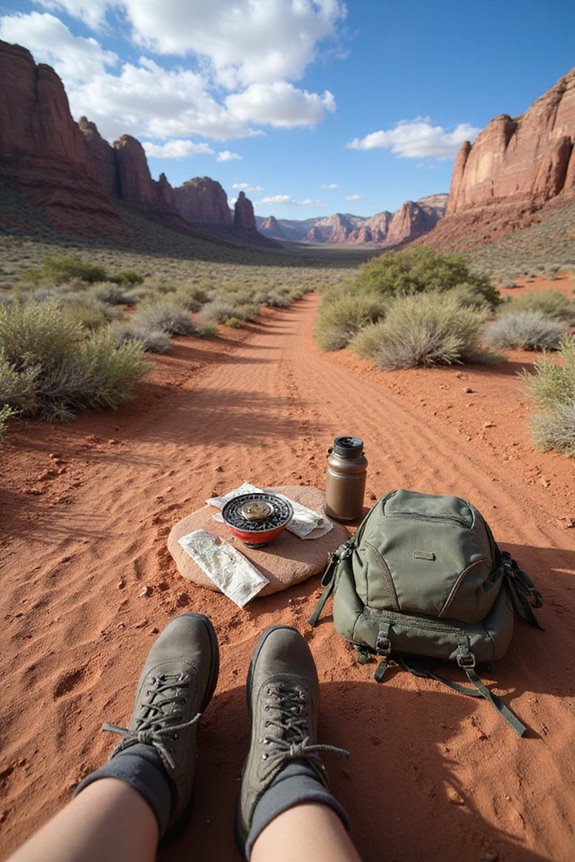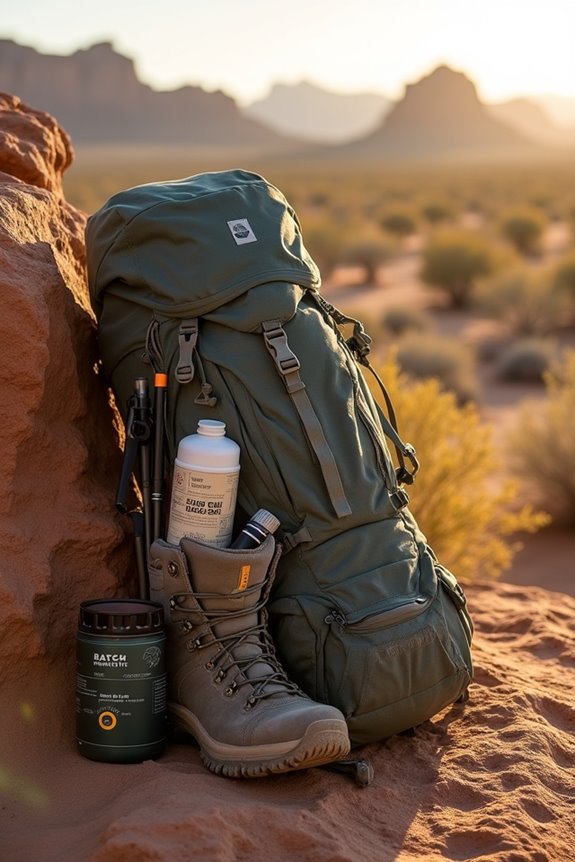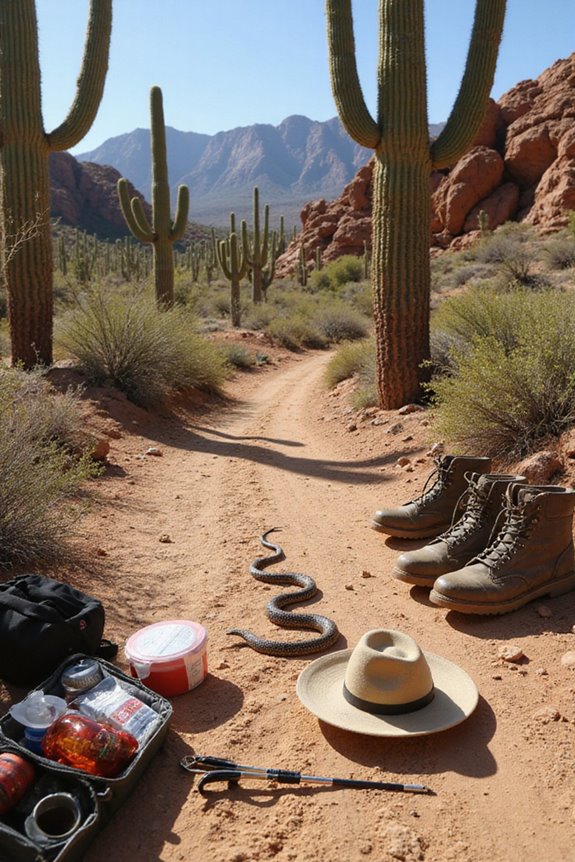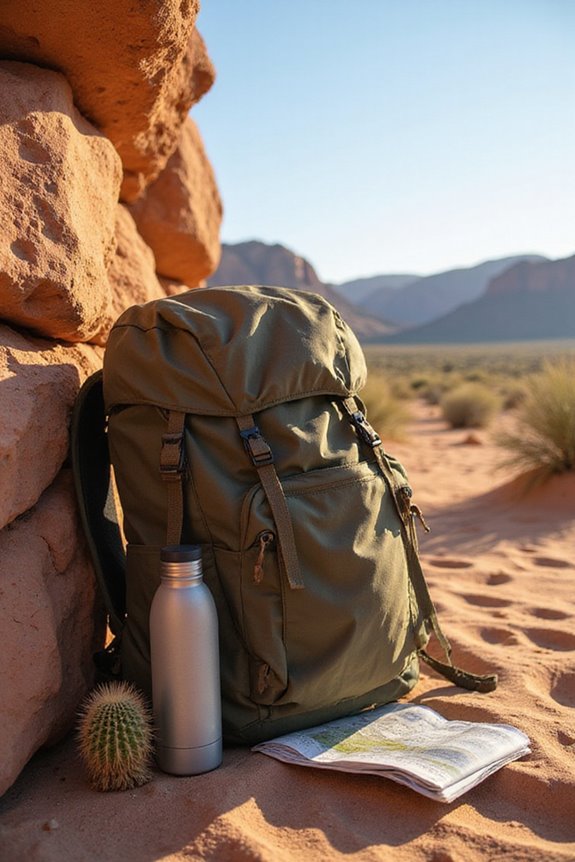When we hit the desert trails, let’s be champions of Leave No Trace! We can research permits and pack layers to tackle those temperature swings. Choosing campsites on durable surfaces like rock or gravel helps protect fragile areas. Remember to dig a cathole for waste (about 200 feet from water!), and keep campfires small or skip ’em altogether. By respecting nature, we help preserve its beauty for future adventurers—trust me, the desert thanks us! Stick around for more tips!
Key Takeaways
- Choose campsites on durable surfaces like rock, sand, or gravel to minimize environmental impact.
- Follow cathole guidelines for waste disposal, digging 6-8 inches deep and 200 feet away from water sources.
- Respect cultural sites by leaving artifacts undisturbed and sticking to designated paths.
- Use lightweight stoves and lanterns instead of campfires to protect vegetation and reduce smoke pollution.
- Keep camping stays short and avoid trampling fragile vegetation to preserve natural ecosystems.
Research and Preparation Before Your Trip
Before we hit the trail, let’s talk prep—it’s the secret sauce for a successful desert adventure! First up, we need to explore permit requirements and local rules. Many desert gems have specific regulations to protect those delicate ecosystems. Trust us, nothing feels worse than finding out we can’t camp where we planned!
Next, let’s chat weather preparedness. It’s a wild ride out there; we’ve got to be ready for heat waves and sneaky flash floods. Knowing the temperature extremes helps us pack wisely—think layers for those chilly nights. Plus, planning our hikes for early morning avoids the midday sun (and our meltdown!). Don’t forget to pack quick-dry clothing with UPF protection to stay comfortable while protecting yourself from the harsh desert sun. With the right research, we can embrace the freedom of the desert like true adventurers!
Choosing Durable Surfaces for Travel and Camping
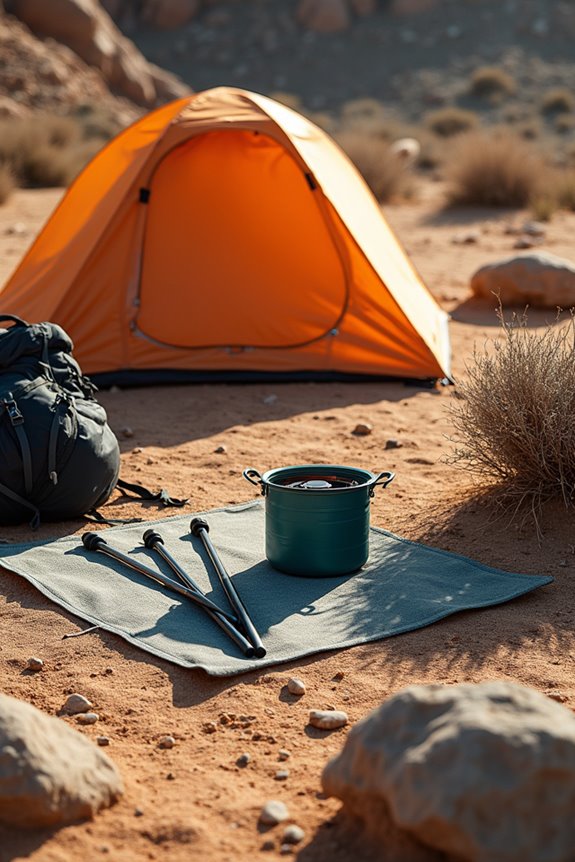
Now that we’ve got our prep game solid, let’s shift gears and talk about where to set up camp and how to wander around without leaving a mark. For campsite selection, we should look for durable surfaces like rock, sand, or gravel—trust me, these are the difference between a respectful visit and a patch of regret. Consider bringing a picnic table cover to further minimize your impact on natural surfaces while eating or preparing meals.
Let’s stay off fragile areas; those lichen-covered rocks can’t take a hit, and cryptobiotic soils? They’re sensitive warriors of the desert! When trekking, it’s best to stick to established trails—navigating around mud only widens our path and knocks down plants. Remember, every step counts, and our fleeting camp stays should be short, sweet, and kind to the land we love!
Proper Waste Disposal Practices
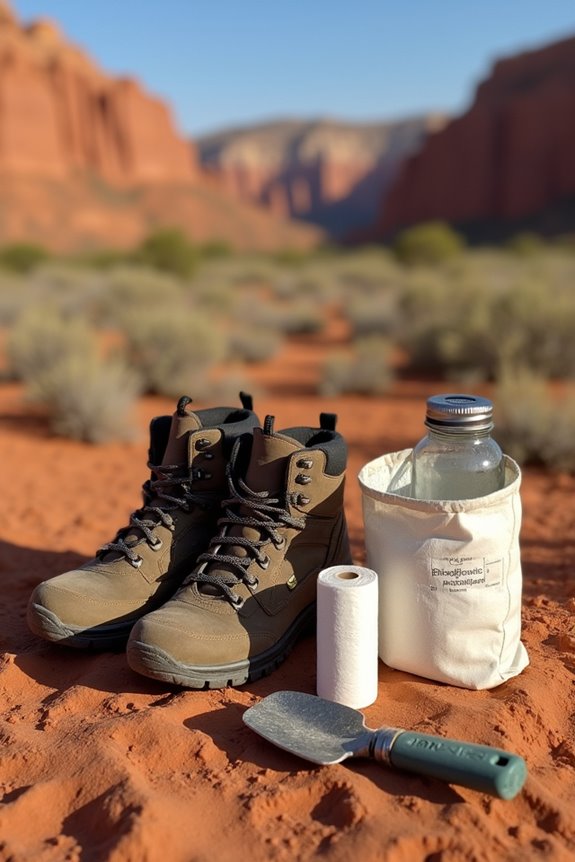
How do we keep the desert pristine and our consciences clear? It starts with proper waste disposal practices! Following cathole guidelines, let’s dig our catholes 6 to 8 inches deep and at least 200 feet from water sources—after all, we’re not trying to welcome wildlife or spoil our favorite water hole. Once we’ve done our business, let’s cover it up with soil to keep things tidy.
When washing dishes, remember to manage wastewater thoughtfully. Strain that dirty dishwater, then pour it out 200 feet from camp. And for toilet paper? Let’s pack it out in sealed bags instead of leaving it behind. For emergencies in remote areas, consider bringing a portable first aid kit with waterproof construction to handle minor injuries while minimizing environmental impact. We love freedom, but a clean desert calls for our commitment—let’s go wild, but responsibly!
Leave Natural and Cultural Resources Untouched
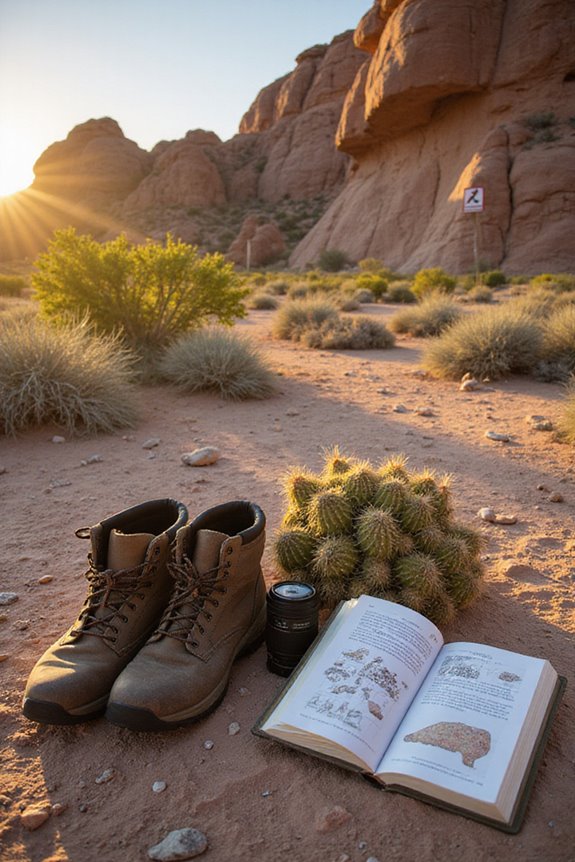
Our commitment to preserving the desert doesn’t stop with proper waste disposal; it extends to leaving natural and cultural resources untouched. We’re not just visitors; we’re stewards! Let’s honor the cultural significance of these sites by leaving artifacts right where we found them. When we veer off established trails, we risk trampling vegetation and damaging delicate environments—yikes! Just like proper setup time matters when choosing camping equipment, your choice to stay on designated paths is crucial for environmental preservation. Imagine stumbling upon ancient rock art; that’s history staring back at us! By staying on designated paths, we protect these treasures and guarantee artifact preservation for future adventurers. Respecting our surroundings enriches our experiences, and besides, nobody wants to be “that person” who disturbs sacred ground. So, let’s keep the desert wild and wonderful—together, we can make a difference!
Minimizing Campfire Environmental Impact
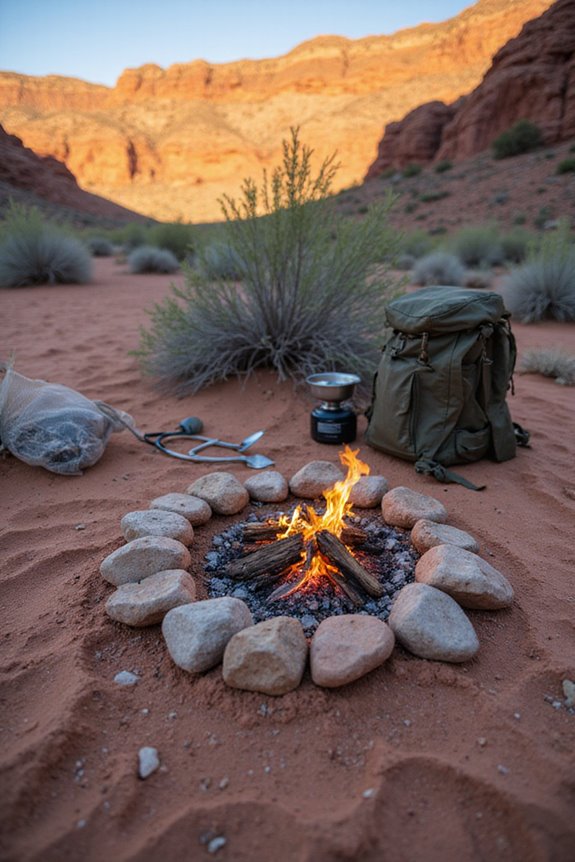
When we gather around a campfire under the vast desert sky, it feels like magic—stars twinkling above, laughter drifting into the night. But let’s be real; campfires can damage these fragile ecosystems long after we’re gone. Instead of building fires, we could opt for fire alternatives, like lightweight stoves and lanterns, which won’t leave scars or deplete precious vegetation. Modern portable camping stoves with high BTU output can efficiently cook meals without damaging the desert environment. If we must have a fire, using fire pans and keeping it small minimizes impact. Remember, our beloved desert deserves protection! Let’s share stories under eco-friendly lighting, avoiding smoke pollution and safeguarding sensitive plant life. Together, we can preserve this enchanting landscape for future adventurers to enjoy the magic too. After all, isn’t freedom about respecting nature as well?
Respecting Wildlife and Maintaining Distance
While we roam the stunning desert landscapes, it’s essential to remember that we’re not alone; a whole array of incredible wildlife calls this arid paradise home. When it comes to wildlife observation, let’s keep our distance and use binoculars or zoom lenses. Approaching animals can stress them and lead to aggressive behavior—we want to keep our adventures stress-free for everyone involved!
Instead of trying to interact or feed them, we should let them thrive on their own. Watching a mother with her young can be heartwarming, but let’s avoid getting between them—trust me, you don’t want to be that person! Let’s explore with respect and admiration, ensuring these wild beauties thrive for future adventurers to enjoy.
Being Courteous to Fellow Visitors
Being considerate of our fellow adventurers is essential for creating a positive desert experience. We all crave that sense of freedom, right? So, let’s practice good camp etiquette! Setting up our campsite within designated areas not only preserves personal space but also keeps our noise levels low. Trust me, nobody wants to hear our late-night jam session!
Let’s share trails with respect, yielding to uphill hikers and keeping the path clear. A friendly wave goes a long way—it’s our desert high-five! Remember to engage in respectful interactions; sometimes, silence speaks volumes. We can all enjoy the solitude while cherishing shared moments. By embracing these simple guidelines, we’ll foster a welcoming vibe that makes every adventure memorable. Let’s keep the desert pristine together!
Adapting to Desert-Specific Challenges
Adapting to the challenges of the desert can be a thrilling experience, especially when we’re prepared and know what to expect. First things first, let’s talk desert survival! We need to research regulations and avoid those sweltering summer months if we can help it. Staying on durable surfaces like gravel or dry creek beds? That’s a must!
Now, hydration strategies are key. Remember, our bodies can’t function well in extreme heat without enough water. So, let’s pack extra! We’ll need it, especially during those peak sun hours. And hey, we should be good stewards by packing out all our waste. When we respect the desert, it’s our playground to explore, and we keep it wild for others—now that’s freedom!
Frequently Asked Questions
What Should I Do if I Encounter Wildlife Unexpectedly?
If we encounter wildlife unexpectedly, let’s maintain safe distances, stay calm, and back away slowly. Observing animals respectfully can enhance our experience while ensuring our safety and theirs in the great outdoors.
Are There Specific Camping Regulations in Different Desert Areas?
When exploring the desert, we must check specific camping regulations and secure necessary camping permits. Following these guidelines helps us enjoy the freedom of nature while protecting the fragile ecosystems that we all cherish.
How Can I Recognize Durable Surfaces for Camping?
When we seek durable surfaces for camping, we’ll look for bare rocks, gravel patches, and flat sand. Employing mindful camping techniques, we’ll tread lightly, ensuring our freedom doesn’t harm the fragile desert environment.
What First Aid Supplies Are Essential for Desert Trips?
For our desert trips, we must pack essential first aid supplies like sterile dressings, antiseptic wipes, and pain relievers. Being prepared helps us embrace the freedom of adventure while staying safe under the sun.
How Can I Educate Others About Leave No Trace Principles?
To educate others about Leave No Trace principles, let’s host community workshops, design engaging educational signage, and inspire conversations that ignite enthusiasm. Together, we can share knowledge and foster a culture of freedom and responsibility outdoors.

